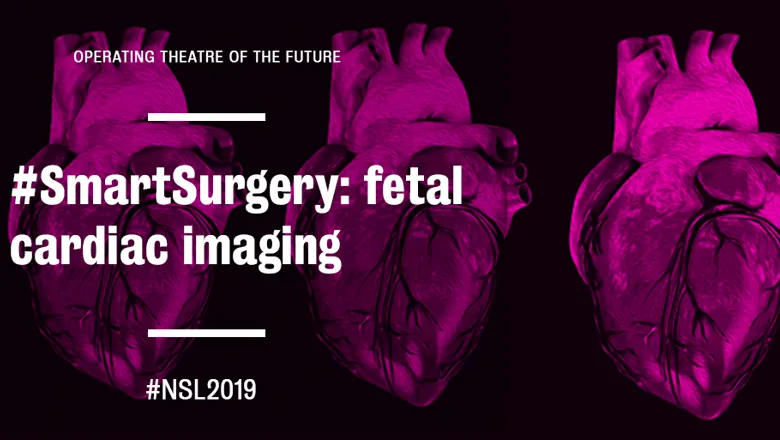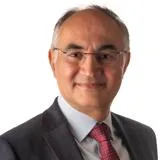11 September 2019
#SmartSurgery: three dimensional fetal cardiac imaging
A breakthrough in fetal cardiac imaging sees production of detailed 3D images of babies hearts before they're even born.

Earlier this year Dr David Lloyd, along with his team, developed a way of using MRI to generate detailed three-dimensional images of babies' heart before they were born. These new techniques allow clinicians to see the vessels around the heart in more detail than had ever been possible before.
More than 250 women carrying a baby with congenital heart disease have volunteered to be scanned in the team’s MRI scanner, helping to get the new technology validated, published, and now commissioned as an NHS clinical service in St Thomas’ - the first of its kind in the world.
“This technology really adds something to the diagnosis of congenital heart disease before birth,” Dr Lloyd said. “We can now generate detailed 3D images of quite complex anatomy in a way that we haven’t been able to before.”
Previously, to achieve the same level of detail, families would wait until the baby had been delivered, stabilised, and sent for a CT scan or an MRI scan.
With this new technology the whole team can plan and communicate with greater certainty to families - all while the woman is still pregnant. “For example, our surgeons can look at the imaging, talk to the parents about what they’re going to do in the operation, what outcomes they expect for the baby and what the risks are,” Dr Lloyd said.
“Many of our children will need surgery, and now we can bring some of the imaging that informs that surgery much earlier, to before they’re even born,” he said.
Changing the capabilities of MRI
Using MRI to scan the heart before birth presents a major technical challenge: the fetal heart beats very quickly at up to 160 beats per minutes, and the baby themselves can also move freely inside the womb.
But Dr Lloyd and team have developed new post-processing computer algorithms which take the simple 2D images from MRI, and then correct them for fetal motion, creating a detailed 3D model that can be analysed away from the scanner.
“One key thing that we noted about the technique in the process of validating it is that it worked in pretty much every case - it was very reliable,” Dr Lloyd said.
“I think that’s one of the reasons why it’s got so much traction from a clinical point of view, and why we’ve now been able to get the technology commissioned as a clinical service for our patients.”
The new service means real advantages for patients. “What we’re able to do is offer the family a much clearer plan of how we can help their baby after birth,” Dr Lloyd said.
He describes one case involving a rare condition where multiple abnormal blood vessels were going to the lungs. These can be notoriously difficult to track with traditional ultrasound, but with 3D MRI imaging doctors could clearly work out exactly how the arterial blood supply to the lungs had formed.
The family met with the surgeon before the baby delivered, who talked them through exactly what surgery would involve. “We were able to confirm the diagnosis after birth and the surgery went exactly as planned,” Dr Lloyd said.
The future of fetal cardiac MRI
To understand why some babies go on to develop more severe forms of congenital heart disease than others, Dr Lloyd and his team are now looking at trying to incorporate other new techniques that can help them look more deeply at the heart, for example, comparing how the left and right side of the heart function, and measuring how much blood is flowing through the blood vessels.
“Then we can actually measure what’s happening in the heart, as well as being able to see it so clearly,” Dr Lloyd said.
This could help with some conditions that are difficult to diagnose before birth, for example coarctation of the aorta, or a narrowing in the main body artery as it leaves the heart. Many newborns are admitted to cardiology units every year with suspected coarctation, but as many as half don’t need any treatment at all. In those that do, the treatment can be life-saving, but in those who don’t it can be expensive, stressful and unnecessary.
Dr Lloyd and his team think the problem may lie deeper than we can see with anatomy alone. "If we can understand the differences between those babies’ hearts in more detail, then we may be able to predict which children are really going to have coarcation and which children aren’t,” he said. "That could potentially have a big impact on many babies who would otherwise get treatment they don’t need, but still pick out the ones who really do need our help,” Dr Lloyd said.
Beyond the heart, Dr Lloyd says he hopes to see the technology evolve in a way that will allow for an unprecedented level of understanding of the fetal cardiovascular system, including how the heart, brain and placenta all grow together. And all this without any anaesthetic, injections, or radiation - a completely harmless way of measuring what’s happening before birth in a way that’s never been possible before.
The iFind Project
The fetal cardiac imaging project is part of the larger iFind Project, which hopes to revolutionise the screening ultrasound scans offered to all women when they are 18-20 weeks pregnant.
The hope with iFind is to produce a standardised ultrasound screening system which is safe, accurate and reliable, and can be used for women around the UK. One critical element in iFind is the use of artificial intelligence (AI), particularly machine learning, to analyse hundreds of thousands of ultrasound images, in the hope of producing an automated way of detecting important fetal abnormalities.
“AI was something we didn’t really anticipate at the beginning of the project, but since we’ve taken it on and applied it to our problem it‘s given us really promising results,” Dr Lloyd said.
At the moment ensuring accuracy is key but ultimately Dr Lloyd said in the future the system could be fully automated, from the point of image acquisition right through to analysis. “The system could then say whether or not the woman needs to be scanned in more detail by a specialist or whether they are safe to carry on without needing a further review,” Dr Lloyd said.
“For the future, the big step for us now is to make sure that when AI makes those types of decisions, it’s making accurate ones.”
If there’s one message that sums up these new technologies, Dr Lloyd says, it’s that “there are technical limits to what we can do in healthcare. We so often wish we could do more for our patients, but sometimes those limits just don’t allow us to deliver the care we want to. There’s a real need for new technologies, to help us and our patients.”
For example, he says, “there’s been a need for something like the fetal cardiac MRI project for a long time. Bringing in new technologies to solve these kinds of problems has been hugely exciting, and watching those technologies provide real benefits for our patients is an incredible feeling.”

